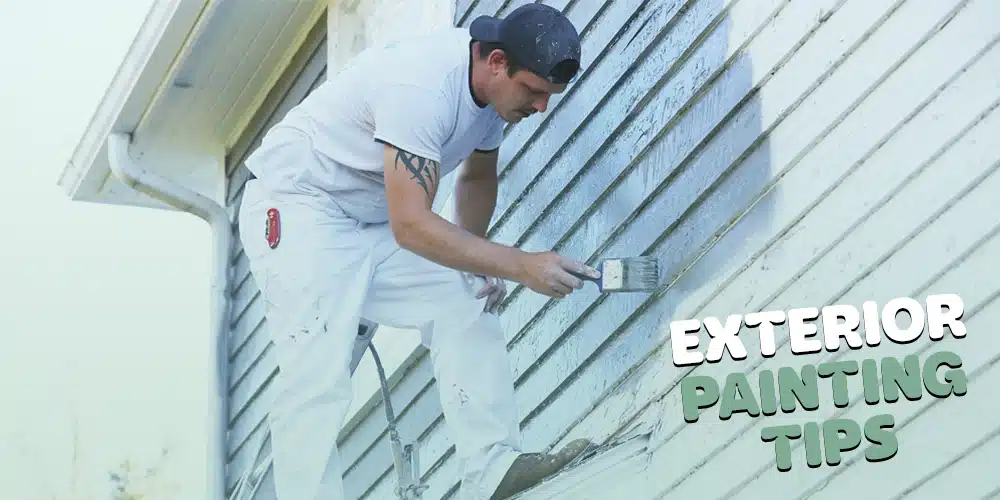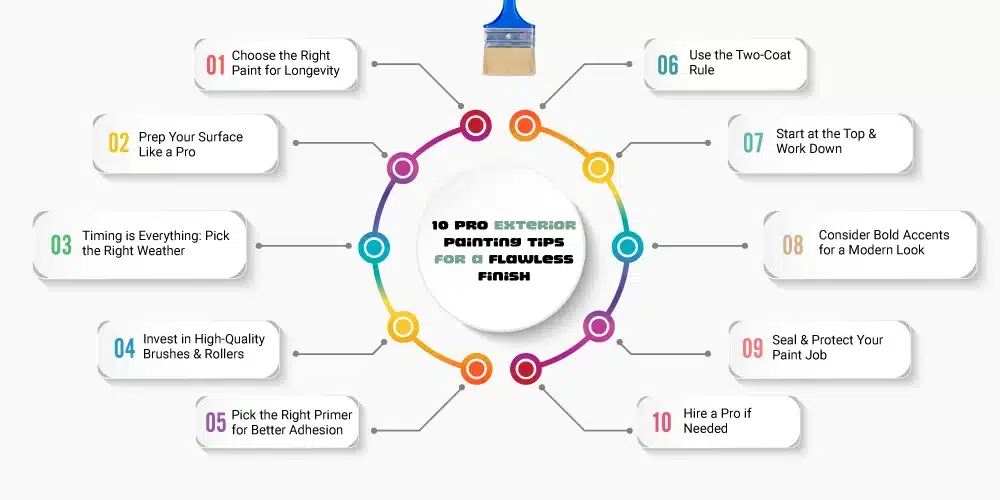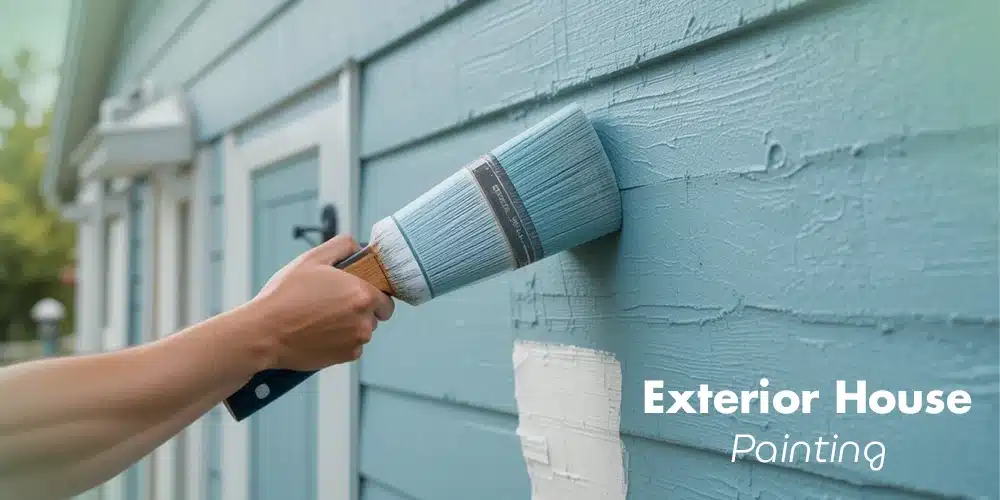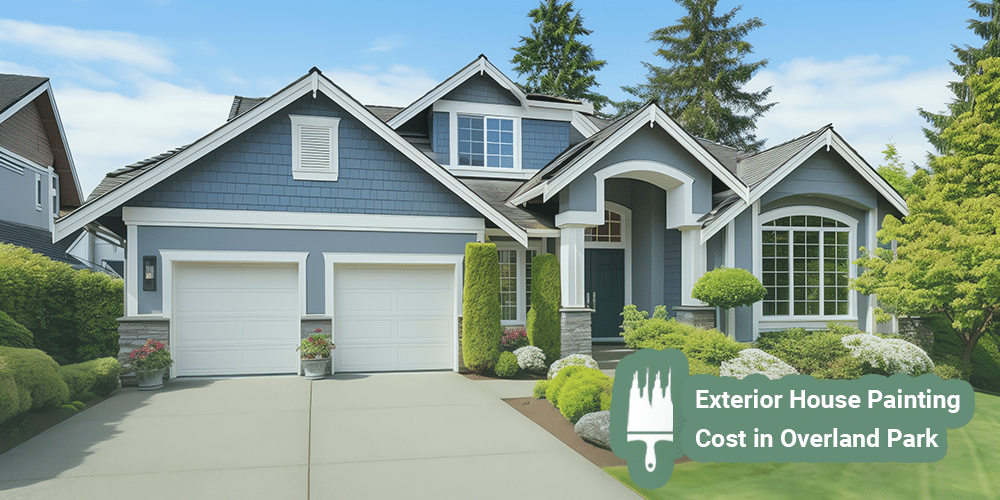A fresh coat of paint can completely transform your home—boosting curb appeal, increasing property value, and shielding it from the elements. But here’s the problem: Most homeowners skip crucial prep steps, leading to peeling, cracking, and faded paint within months. If you’re a homeowner planning to repaint in 2025, you need more than just the right colour—a strategy for long-lasting, professional results. From choosing the best weather conditions to using the right tools, these 10 expert-backed tips will help you avoid costly mistakes and ensure your home looks flawless for years
Don’t waste time and money on a paint job that won’t last. Follow these steps to get it right the first time.
10 Pro Exterior Painting Tips for a Flawless Finish
Follow these expert-backed tips to choose the right paint, prep surfaces, and apply with precision—ensuring a long-lasting, professional-quality finish for your home!
According to a study by Silva et al. (2024), various exterior paint types, including PVA, matte acrylic, silicate, and lime paints, were analyzed for their durability and effectiveness in conserving historic building façades. The research highlights that high-quality paints with advanced formulations significantly improve longevity and weather resistance, making them a preferred choice for exterior applications.
1. Choose the Right Paint for Longevity
Not all paints are created equal. Cheaper paints may save money upfront, but they fade, peel, or crack within a few years, forcing you to repaint sooner. Investing in high-quality exterior paint ensures durability, better coverage, and long-term protection for your home.
What to Look for in Exterior Paint:
- Weather-resistant: Paint should withstand harsh sun, heavy rain, snow, and temperature fluctuations without fading or cracking.
- Mold & mildew-resistant: Essential for homes in humid or coastal areas where moisture buildup can lead to damage.
- Low-VOC & eco-friendly: Volatile Organic Compounds (VOCs) release harmful fumes. Opt for low-VOC or zero-VOC options for a safer home environment.
- Fade-resistant pigments: Ensures your color stays vibrant for years.
- Elasticity & flexibility: Prevents cracking on surfaces that expand and contract with temperature changes.
Did You Know: In 2025, self-cleaning exterior paints are trending. These use nanotechnology to repel dirt and moisture. The global nano coating market, encompassing self-cleaning applications, was valued at $9.2 billion in 2024 and is projected to grow at a CAGR of over 16.8% between 2025 and 2034. |
2. Prep Your Surface Like a Pro
A flawless paint job starts with proper prep work. Skipping this step is the #1 reason for peeling, uneven coverage, and premature fading. No matter how high-quality your paint is, it won’t stick well to a dirty, rough, or damaged surface.
Step-by-Step Surface Prep:
- Wash the walls – Use a pressure washer to remove dirt and grime.
- Scrape off loose paint – Peeling areas must go!
- Sand rough spots – Smooth out imperfections.
- Repair cracks & holes – Use exterior caulk for gaps.
- Prime bare surfaces – Helps paint adhere better.
_________________________________________________________________
Don’t Skip This! If you paint over dirty or flaking surfaces, the new paint won’t stick properly.
_________________________________________________________________
3. Timing is Everything: Pick the Right Weather
Painting at the wrong time can ruin your hard work. Too much heat makes exterior paint dry too quickly, leading to cracks and brush marks. High humidity prevents proper drying, causing streaks and bubbling. To get a smooth, long-lasting finish, you need the perfect balance of temperature, humidity, and timing.
Best Weather for Exterior Painting:
- Ideal Temperature: 50-85°F (10-30°C) : Extreme temperatures affect paint application.
- Too hot (above 85°F/30°C): Paint dries too fast, leading to uneven texture and visible strokes.
- Too cold (below 50°F/10°C): Paint takes too long to dry, increasing the risk of smudging, dust accumulation, and improper adhesion.
- Ideal Humidity: Below 50%: Humidity slows down drying time and can cause paint to become sticky or form bubbles.
- High humidity (above 70%) can trap moisture inside the paint film, leading to peeling and mold growth.
- Low humidity (below 50%) ensures the paint dries evenly and adheres well.
Best Time of Day: Morning or Late Afternoon
Direct sunlight heats surfaces too quickly, causing premature drying and uneven coverage. The best approach is to follow the shade and paint when the surface is cool but dry.
- Start painting early morning (before 10 AM) when temperatures are stable.
- Avoid midday heat when the sun is strongest.
- If painting in the afternoon, wait until the sun moves away from the area.
Avoid: Painting before rain, on windy days, or in extreme heat. According to a study published in the journal Coatings , excessive wind speeds during the drying process of waterborne paint films can lead to defects such as cracks, crusts, and wrinkles. The research found that an optimal wind speed of 1 m/s improved the drying rate without compromising the quality of the paint film. Therefore, it’s advisable to avoid painting under high wind conditions to ensure a smooth and durable finish. |
4. Invest in High-Quality Brushes & Rollers
Many homeowners make the mistake of using cheap brushes and rollers to save money. But low-quality tools can leave streaks, uneven coverage, and even shed bristles into your fresh paint, ruining the finish. If you want a smooth, professional-looking paint job, investing in high-quality tools is a must.
Surface Type | Best Tool |
Siding & Walls | High-nap roller (¾-inch) |
Trim & Doors | Angled brush |
Large Areas | Paint sprayer |
__________________________________________________________________
Pro Tip: A paint sprayer speeds up the job and gives an ultra-smooth finish.
_______________________________________________________
5. Pick the Right Primer for Better Adhesion
Many homeowners skip primer to save time, but that’s a big mistake. A good primer creates a strong bond between the surface and paint, ensuring long-lasting durability and even coverage. Without it, paint can peel, crack, or appear blotchy within months.
- Painting over bare wood or metal.
- Switching from dark to light colors.
- Dealing with high-moisture areas.
Surface Type | Best Primer Type | Why? |
Bare Wood | Oil-based or latex primer | Seals porous wood & prevents stains |
Metal (iron, steel) | Rust-inhibiting primer | Protects against corrosion |
Previously Painted Walls | Latex-based bonding primer | Ensures strong adhesion for new paint |
High-Moisture Areas | Mold-resistant primer | Prevents mildew & peeling in humid climates |
Dark to Light Color Change | High-hide white primer | Blocks old color & improves coverage |
___________________________________________________________________
🛑 Skipping primer = uneven color & poor adhesion.
___________________________________________________________________
6. Use the Two-Coat Rule
Applying just one coat of paint might seem like a time-saver, but it’s a short-term fix that won’t hold up against harsh weather. A two-coat application ensures even coverage, enhanced durability, and a longer-lasting finish.
- Better Coverage: Ensures an even, rich color.
- Increased Durability: Protects against weather damage.
- Longer Lifespan: Lasts 5-10 years longer than a single coat.
_________________________________________________________________
📌 Pro Tip: Let the first coat dry completely before applying the second.
________________________________________________________________
7. Start at the Top & Work Down
Painting in the wrong order can lead to drips, streaks, and an uneven finish. The best technique? Always start at the highest point and move downward. This way, you can smooth out drips as you go and avoid messing up already-painted areas.
Correct Painting Order:
1️⃣ Ceilings & Overhangs
2️⃣ Walls & Siding
3️⃣ Trim & Windows
4️⃣ Doors & Shutters
________________________________________________________________
🛑 Mistake to Avoid: Painting windows last—drips can ruin fresh trim paint!
_________________________________________________________________
8. Consider Bold Accents for a Modern Look
Want to make your home stand out in 2025? Bold accent colors are the way to go! Adding contrast to doors, trim, and shutters creates depth, character, and curb appeal. Whether you prefer a classic or modern aesthetic, the right accent color can transform your home’s exterior.
Trending Color Combinations:
- Navy Blue + White Trim
- Earthy Green + Black Accents
- Warm Beige + Dark Brown Doors
__________________________________________________________________
Pro Tip: A bold front door adds personality and boosts resale value.
__________________________________________________________________
9. Seal & Protect Your Paint Job
A fresh paint job isn’t just about looks—it’s also your home’s first line of defense against weather, dirt, and damage. Without proper maintenance, even the best-quality paint can fade, crack, or peel over time. Protect your investment with a few simple upkeep steps to keep your home looking freshly painted for years!
✔️ Wash annually to remove dirt & mildew.
✔️ Inspect for cracks or chips every spring.
✔️ Trim trees & bushes to prevent scratches.
__________________________________________________________________
🛑 Neglecting maintenance = repainting sooner!
__________________________________________________________________
10. Hire a Pro if Needed
Painting your home’s exterior can be a rewarding DIY project, but sometimes, hiring a professional is the smarter choice. Experienced painters ensure a flawless, long-lasting finish, saving you time and preventing costly mistakes.
When to Hire a Painter:
- Large or multi-story homes.
- Difficult surfaces (stucco, brick, or metal).
- No time or experience.
💰 Cost Estimate (2025 Pricing):
Home Size | DIY Cost | Pro Cost |
Small (1,500 sq ft) | $500-$1,500 | $2,500-$4,000 |
Medium (2,500 sq ft) | $1,000-$3,000 | $4,000-$7,000 |
Large (4,000+ sq ft) | $3,000+ | $7,000-$12,000 |
_________________________________________________________________
📌 Pro Tip: Get at least three quotes before hiring a painter.
__________________________________________________________________
Final Thoughts: Upgrade Your Bathroom with the Right Tub
A flawless exterior paint job does more than just refresh your home—it protects, enhances, and adds lasting value. But achieving that perfect finish requires the right paint, proper preparation, and expert techniques. Whether you’re tackling it yourself or hiring professionals, following these tips ensures a durable, stunning result.
If you want a hassle-free, top-quality exterior transformation, trust Aaron’s Painting & Remodeling. Our experienced painters in Overland Park use premium materials and proven techniques to deliver exceptional results. Don’t settle for peeling, fading paint—contact us today and give your home the long-lasting beauty it deserves!
Get a free estimate now!




